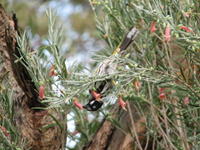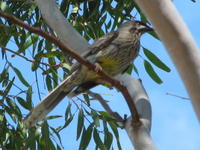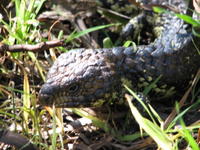How sweet it is
I have been trying for several days to capture a New Holland Honeyeater doing their usual gymnastic tricks while feeding. Just before lunch today I managed to get one upside down feeding from a flower in an Eremophila youngii. Eremophilas are commonly called Emu Bushes.

No – I haven’t inserted the photograph upside down! It’s the bird that is upside down. The curved beaks of the Ausralian honeyeaters are ideally suited to feeding from many of the Australian plants like the Eremophilas, Correas and Prostantheras with their tube shaped flowers. Of course the New Holland Honeyeaters don’t have it all to themselves. The Red Wattlebirds also insist on their fair share of the spoils. The above photo shows a Red Wattlebird busy in another eremophila nearby. A few seconds after this photo was taken a New Holland Honeyeater tried to chase the wattlebird away, only to have the tables turned and become the one being chased.
Of course the New Holland Honeyeaters don’t have it all to themselves. The Red Wattlebirds also insist on their fair share of the spoils. The above photo shows a Red Wattlebird busy in another eremophila nearby. A few seconds after this photo was taken a New Holland Honeyeater tried to chase the wattlebird away, only to have the tables turned and become the one being chased.
 Wattlebirds can be bossy creatures, especially if another bird tries to muscle in on their patch of food. The above photo shows a rare moment in the life of a Red Wattlebird – sitting peacefully on a branch of a Eucalyptus citriodora or Lemon Scented Gum. On closer inspection of the photo I just realised that this individual is keeping the above eremophila plant under surveillance.
Wattlebirds can be bossy creatures, especially if another bird tries to muscle in on their patch of food. The above photo shows a rare moment in the life of a Red Wattlebird – sitting peacefully on a branch of a Eucalyptus citriodora or Lemon Scented Gum. On closer inspection of the photo I just realised that this individual is keeping the above eremophila plant under surveillance.
 My new interest in butterflies continues unabated. I didn’t realise how many butterflies we have around our garden until I started quietly stalking them, camera poised. Today I managed several reasonable shots of the Vanessa kershawi or the Australian Painted Lady butterfly. We have at least two other species common in our garden, but I have yet to get a good shot of them. I know of at least two other species that have visited in the past but I haven’t seen them for several years.
My new interest in butterflies continues unabated. I didn’t realise how many butterflies we have around our garden until I started quietly stalking them, camera poised. Today I managed several reasonable shots of the Vanessa kershawi or the Australian Painted Lady butterfly. We have at least two other species common in our garden, but I have yet to get a good shot of them. I know of at least two other species that have visited in the past but I haven’t seen them for several years.
Here’s another challenge I could set myself. Try to get some photos of the dragonflies we have around here! Then I could move on to other insects, such as ants and beetles. And what about caterpillars? Oh, and then we have quite a selection of reptiles, including Brown Snakes (which are very dangerous so I don’t want to get too close; the zoom lens will help there).
 As for lizards, they are on the move already. I have included a photo taken yesterday of a Stumpy-Tailed Lizard (also called a Shingleback). We have quite a few individuals on our little estate. I haven’t seen any young Stumpy-Tails for a few months. We did see several in the autumn months. We enjoy seeing them come to one of the bird baths for a drink. The Aussie expression “flat out like a lizard drinking” is so apt. To illustrate how common this species is in the Murray Bridge area, our local poetry competition is called “The Stumpies”. I’ll try to get a link to details of this award.
As for lizards, they are on the move already. I have included a photo taken yesterday of a Stumpy-Tailed Lizard (also called a Shingleback). We have quite a few individuals on our little estate. I haven’t seen any young Stumpy-Tails for a few months. We did see several in the autumn months. We enjoy seeing them come to one of the bird baths for a drink. The Aussie expression “flat out like a lizard drinking” is so apt. To illustrate how common this species is in the Murray Bridge area, our local poetry competition is called “The Stumpies”. I’ll try to get a link to details of this award.
We also have a range of geckoes and skinks on our land, all of them quite beautifully marked and would make wonderful photographs to include in this journal. Then we have the following mammals present (or occasional visitors): Western Grey Kangaroo, Common Brushtail Possum, Short-Beaked Echidna, Brown Hare*, European Rabbit*, House Mouse*, Black Rat*, Red Fox* and feral cat*(*introduced). I am sure we probably also have four or five species of bats but I’ve only indentified the Western Broad-Nosed Bat.
Mmmm… methinks I’ve opened a can of worms here!
Worms???
How photogenic are worms??
PS. I’m so pleased I do not have to buy film for this new camera.
CURRENTLY IN SOUTH AUSTRALIA DUE TO THE HEAT WAVE THE FOOD SUPPLY FOR HONEY EATERS AS WELL THE NUMBER OF BIRD POPULATIONS ARE RAPIDLY DECREASING IN OUR BACKYARD. WHAT CAN WE DO TO ASSIST IN THESE TIMES OF LONG LASTING EXTREME WEATHER? what is the food supply I could put out onto the bushes for these tiny winged creations? CHEERS LISA SIMONE
Thanks for your comments and question Lisa.
Honeyeater populations change frequently due to many factors and generally heat wave conditions are only temporary, lasting from a few days to about a week and do not change the food supply significantly.
What you are observing in the decline of honeyeaters is quite complex in its cause and relatively common. Most Australian native plants do not flower throughout the year and some only flower for a few weeks. Other plants, like some of our eucalyptus species may only flower every second or third year, depending on many factors, including rainfall. In any patch of scrub or forest there will be some flowering plants and many that are not flowering.
When there are plenty of flowers in a given area – and therefore much food for honeyeaters – numbers can increase rapidly with birds migrating from nearby areas where there is less food. Many honeyeater species migrate readily, some of them hundreds of kilometres. It is the supply of food that determines the numbers, not heat waves.
An added factor is the supply of insects. Many honeyeaters are also insectivorous and the numbers of insects available will also determine how many birds are present. Generally it is my observation that insect numbers increase during hot weather which favours the birds.
What can you do?
1. For the long term survival of all bird species plant a wide range of Australian native plants in your garden and encourage neighbours to do the same. This will not only ensure a long term food supply for birds, it will encourage biodiversity and bring in small mammals (eg possums), butterflies and other creatures.
2. In the short term, artificial feeding is discouraged for reasons too complex to go into here.
3. In the broader picture, discourage people from allowing cats into gardens. They are predators on small birds and a major contributor to the decline of birds in our gardens.
4. The best way to keep many birds in your garden is to supply fresh water in various shady spots but well out of reach from predators like cats. Bird baths are quickly found by birds in hot conditions and will ensure they stay around. Watching them drink and bathe also gives us as bird lovers much pleasure as we watch them.
Hope this has all helped.
Because you asked the same question on 3 different posts I am copying these answers on all 3 for other readers of this site.